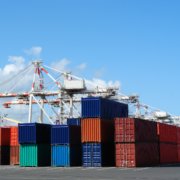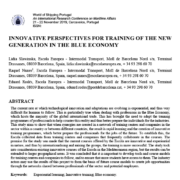A box management ecosystem to solve the empty container dilemma
We need to re-oriente our thinking towards container management, argues Nicholas Press from CEC Systems.
Visibility is a high priority for shippers and carriers alike. Whether it is rate comparison, booking freight, tracking or monitoring a temperature-sensitive container, visibility is a necessity in today’s market. The growing number of technology providers providing visibility such as Traxens, Savi and EyeSeal and the evolution of interoperability of solutions improvements. The goal in much of these improvements is to provide shippers with more accurate, up-to-date location data and better analytics about where and why cargo bottlenecks occur.
While improving visibility is important, for the industry to achieve sustained improvements it needs to recognize that there are many inputs and relationships that surround the movement of containers which are integral to the successful movement of goods globally. There is a bigger picture that is often overlooked, however. That bigger picture is not solely focused on container transaction but rather, a container ecosystem that encompasses the entire lifecycle of containers and tracking devices – from research & development of hardware, the manufacturing process, ownership, maintenance, loading, booking, and tracking, final delivery, the repositioning and storage of the empty containers and, ultimately, the recycling of the containers.
If the industry is going to generate real efficiencies, there must be a move away from siloed management of containers towards a holistic approach.
Container management must be an ongoing evolution that brings four key areas of focus into an ecosystem. Effective management relies on more than just box optimization, it requires the physical, digital, analytics and services to be considered as equal parts of an overall solution. These four areas form a container ecosystem that when viewed and managed together, offer a comprehensive and integrated solution for the efficient use of containers.
Proper management of empty containers, for example, warrants extra attention as empty containers are one of the most significant areas of lost profit. The four areas (physical, digital, analytics, and services) interconnect and as you look to optimize and create new efficiencies in one area, you must also seek the advancement of the other three. Without a level of concurrent progress, the industry is potentially advancing without the strong foundation required to achieve real efficiencies. For example, as we at CEC Systems continue to evolve the collapsible container design, we will continue to develop and evolve the other areas in unison.
Begin with the physical
Let’s start with the design of the container. The global shipping and logistics industry is losing over $30bn annually on storing, handling and distributing empty containers but the general design of the box has not really evolved over the past 40 years. There is a good reason for this as there needs to be an international standard that allows freight to move across borders, but that doesn’t make it optimal in achieving long-term sustainability.
Instead of waiting for international standards to catch up with changing shipping needs, CEC Systems has developed COLLAPSECON – the world’s first semi-automated Collapsible-Economic-Container that enables four empty units to be collapsed and combined to form a single container, thus significantly reducing the cost of storing, handling and distributing empty containers. By utilising containers that collapse and combine, we are able to achieve a greater level of asset utilisation and availability across the global fleet. The result of this is a reduction in waste, bottlenecks, and congestion throughout the global network and a contribution towards a sustainable industry.
Although the container forms the physical part of the empty container issue it would be a mistake to focus only on this part as it does not take into account the other three container management areas. However, by re-orienting our thinking and making the container itself part of the container management ecosystem alongside tracking, analytics, and services, the combined effect is an improvement in operational efficiency and provisions a better return on investment and reduced environmental impact when compared to standard containers.
Add the digital
While the container itself as a physical item is the primary concern, we cannot proceed as an industry from shying away from the benefits digitalization brings. It is all very well and good that we seek to evolve the box itself, but we must in parallel be seeking to make containers as smart as possible.
As part of the ecosystem, the industry should be aiming to provide a new level of efficiency to tracking and optimizing container movements. If the industry desires real efficiencies, technology should allow a participant to monitor not only the container but the pallet, the box, the packet as well as have the ability to drill down to the level of detail to the individual product inside. Tracking should provide real-time and actionable information and through the use of blockchain, ensure the security and accuracy of data throughout the value chain. Trading partners, as well as service providers, will gain better visibility in their supply chains and understand their true costs of operation. This, in turn, can allow them to remove recurring issues from their network.
Achieving improved container management through the use of digital technologies and tracking may sound like a monumental challenge and very expensive, but in today’s digital age, the cost of technology continues to decline and many solutions exist to provide the level of visibility needed within the ecosystem parameters for improved container management.
Analysis and insights
A growing number of technologies such as sensors are not only tracking container location but also temperature, humidity levels and even the number of bumps along the route. In addition, sensors are sending information to improve the accuracy of data that may not have been caught or able to be managed through manual means.
However, big data is useless unless you can pull “actionable” data out of it. For an ecosystem to work a fundamental breakdown of data and information silos across the network is necessary. The knowledge and data provided by these devices and sensors need to be captured, securely stored in the blockchain and transformed into insights. It is not about generating more data, it is about generating knowledge and understanding to support better decision making.
Members of the ecosystem should be able to analyse their networks at both the macro and micro levels to create transparency, support continuous improvement, and create value for the stakeholders with their investments.
The result being, better analysis, actionable insights, accountability, and greater efficiencies. Not just for the operator or shipper, but for the industry as a whole.
Services to support the ecosystem
Adding to the physical, digital and analytics aspects, in terms of services, we can break this into three different components. There is the maintenance of existing assets, the continuous development of underlying technologies and the support services to enable functionality and operations. These services can include the management of containers, research & development, inspection, repair, requisite training and in the case of collapsible containers, collapsing as a service.
This is incredibly important to understand, as the ecosystem is about more than just a physical container and digital technologies. It’s about ensuring containers and other hardware such as tracking devices and underlying technologies are treated as assets, not commodities. If consideration is not provided then assets become useless before the end of their potential life span. Beyond lost revenue and poor service, the result is the need to build more units at additional financial and environmental costs.
We at CEC Systems envision these supporting services for the ecosystem that is similar to how aircraft are maintained… just far less complicated and life critical. As the fleet owner, we will look to develop our own maintenance services over time but we also will rely on partners in regions to ensure the ecosystem is maintained and users see the greatest benefit.
Not only do these services extend to a deeper level of customer service (satisfaction) but they also prolong the life and utilization of the hardware across the ecosystem, making them a more profitable investment for shippers and carriers alike.
How the ecosystem naturally begets sustainability
In the container management ecosystem, there needs to be greater attention paid not just to what happens when a container is built and used for the movement of goods, but throughout the containers entire life cycle. In particular, as we discussed it above, there needs to be a move away from market dumping/asset write off towards treating containers, other hardware, and software as important assets like ships and ports. In case of containers, for example, that means one needs to consider how containers are made, where materials are sourced from, what materials are used, what quality assurance processes are considered, how they are repaired, how they are used and in the end, how they are properly disposed of.
While they may not be able to be used on the seas, they can be modified for other purposes such as emergency accommodation to support disaster relief or short-term accommodation for those without a home (and in some cases, entire Apartment Communities built out of old containers). There are plenty of options for the faithful box but as part of the physical area of the container management ecosystem, we will end up with thousands of containers spread throughout the world. Where possible, recycling of these assets should be placed as a top priority.
In conclusion
Creating and supporting a container ecosystem creates a holistic approach to container shipping in a way that hasn’t been considered before. In terms of organizational health, the ability to collapse and store four containers in the space of one will go a long way towards saving companies money. By investing in the life cycle of these containers, fewer resources will be poured into making new ones which will also protect both the environment and the profit margin. The hardware and software that goes into managing containers will provide a new level of visibility throughout the supply chain increasing both agility and efficiency. The service offering created through this arrangement not only helps to support the container ecosystem but will also serve to deepen and, subsequently, strengthen the working relationships between collaborating partners.
By re-orienting our thinking towards a container management ecosystem consisting of the physical, tracking, analytics, and services, the combined effect will be a long-term improvement in operational efficiency, better return on investment and reduced environmental impact.
Source: Splash 247









